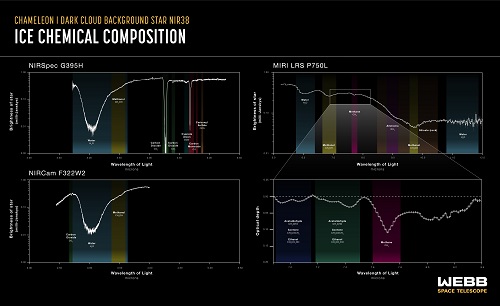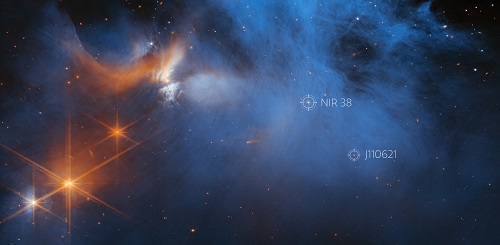Home > Headlines > Webb Unveils the Dark Side of Pre-stellar Ice Chemistry
Webb Unveils the Dark Side of Pre-stellar Ice Chemistry
by - 23 January 2023

An international team, including researchers from CNRS, has been able to measure the composition of interstellar ices in the darkest and coldest regions of a molecular cloud measured to date, using observations from the NASA/ESA/CSA James Webb Space Telescope (JWST). This result published in Nature.com allows astrophysicists to prefigure the simple ice molecules that will potentially be incorporated into future exoplanets, while opening a new window on the origin of more complex molecules that are the starting point for the formation of the first building blocks of prebiotic interest.
Release on NASA website
Release on ESA website
Ices are an essential ingredient in planet building as they are a good carrier of light elements such as carbon and oxygen for incorporation into planetary atmospheres and the basis for the chemistry of prebiotic molecules such as sugars, alcohols and simple amino acids. In tenuous regions of space, icy dust grains provide a unique setting for atoms and molecules to meet, which can promote chemical reactions that lead to the formation of molecular species.
In this study, the team targeted ices in a particularly cold, dense and hard-to-study region of the Chameleon I molecular cloud, a region about 600 light years from Earth that is currently forming dozens of young stars. The study provided a detailed inventory of the deepest buried ices measured to date in a molecular cloud. In addition to simple ices such as water, as well as the normal and heavy isotopes of carbon dioxide and carbon monoxide, the team was able to identify several other condensed species, including the cyanate anion, carbonyl sulphide - observed for the first time in a dense cloud - and the first organic molecule considered complex in space, methanol. This is the most comprehensive survey to date of the icy ingredients available to make future generations of planets, before they are heated during the formation of young stars.
This research is part of the Ice Age project, one of 13 JWST Early Release Science programmes led by Dr Melissa McClure, an astronomer at Leiden Observatory. These observations are designed to showcase the observational capabilities of JWST and allow the astronomical community to learn how to make the most of its instruments. The ’Ice Age’ team is already planning further observations, and hopes to trace the path of ice from its formation to the assembly of potential icy comets.
This research is described in a paper recently published in the journal Nature Astronomy and is the subject of a NASA, ESA, STSCI press release

- Spectra of one of the lines of sight of a star in the background of the Chameleon I cloud obtained with several JWST instruments (NIRSpec and NIRCam) to probe and make a detailed inventory of the deepest ices measured to date in a molecular cloud.

- This image by the NASA/ESA/CSA James Webb Space Telescope’s Near-InfraRed Camera (NIRCam) features the central region of the Chameleon I dark molecular cloud, which resides 630 light years away. The cold, wispy cloud material (blue, centre) is illuminated in the infrared by the glow of the young, outflowing protostar Ced 110 IRS 4 (orange, upper left). The light from numerous background stars, seen as orange dots behind the cloud, can be used to detect ices in the cloud, which absorb the starlight passing through them.
Image Credit: NASA, ESA, CSA, and M. Zamani (ESA/Webb); Science: M. K. McClure (Leiden Observatory), F. Sun (Steward Observatory), Z. Smith (Open University), and the Ice Age ERS Team.
###
JWST is an international partnership between NASA, ESA and the Canadian Space Agency (CSA).
International team :
M. K. McClure (Leiden Observatory, Leiden University), W. R. M. Rocha (Laboratory for Astrophysics, Leiden Observatory), K. M. Pontoppidan (Space Telescope Science Institute), N. Crouzet (Leiden Observatory, Leiden University), L. E. U. Chu (NASA Postdoctoral Program Fellow, NASA Ames Research Center), E. Dartois (Institut des Sciences Moleculaires d’Orsay (ISMO), CNRS/Univ. Paris-Saclay), T. Lamberts (Leiden Institute of Chemistry, Gorlaeus Laboratories & Leiden Observatory, Leiden University), J. A. Noble (Physique des Interactions Ioniques et Moléculaires (PIIM), CNRS/Aix-Marseille Univ.), Y. J. Pendleton (Department of Physics, University of Central Florida), G. Perotti (Max Planck Institute for Astronomy), D. Qasim(Solar System Exploration Division, NASA Goddard Space Flight Center & Department of Physics and Astronomy, Howard University), M.G. Rachid (Laboratory for Astrophysics, Leiden Observatory), Z.L. Smith (School of Physical Sciences, The Open University), F. Sun (Steward Observatory, University of Arizona), Tracy L Beck (Space Telescope Science Institute), A. C. A. Boogert (Institute for Astronomy, University of Hawai’i at Manoa), W. A. Brown (Department of Chemistry, University of Sussex), P. Caselli (Max-Planck-Institut fur extraterrestrische Physik), S.B. Charnley (Solar System Exploration Division, NASA Goddard Space Flight Center), M. N. Drozdovskaya (Center for Space and Habitability, Universitaet Bern), E. Egami (Steward Observatory, University of Arizona), J. Erkal (Institute for Astronomy, University of Hawai’i at Manoa), H. Fraser (School of Physical Sciences, The Open University), R. T. Garrod (Departments of Astronomy & Chemistry, University of Virginia), D. Harsono (Institute of Astronomy, Department of Physics, National Tsing Hua University), S. Ioppolo (Center for Interstellar Catalysis, Department of Physics and Astronomy, Aarhus University), I. Jiménez-Serra (Centro de Astrobiología (CAB), Ctra. de Ajalvir), M. Jin (Solar System Exploration Division, NASA Goddard Space Flight Center & Department of Physics, Catholic University of America), J. K. Jørgensen (Niels Bohr Institute, University of Copenhagen), L. E. Kristensen (Niels Bohr Institute, University of Copenhagen), D.C. Lis (Jet Propulsion Laboratory, California Institute of Technology), M. R. S. McCoustra (Institute of Chemical Sciences, Heriot-Watt University), Brett A. McGuire (Department of Chemistry, Massachusetts Institute of Technology and National Radio Astronomy Observatory), G.J. Melnick (Center for Astrophysics | Harvard & Smithsonian), Karin I. Öberg (Center for Astrophysics | Harvard & Smithsonian), M. E. Palumbo (INAF - Osservatorio Astrofisico di Catania), T. Shimonishi (Faculty of Science, Niigata University), J.A. Sturm (Leiden Observatory, Leiden University), E.F. van Dishoeck (Leiden Observatory, Leiden University), and H. Linnartz (Laboratory for Astrophysics, Leiden Observatory).
Links
• Publication :
https://www.nature.com/articles/s41550-022-01875-w (DOI: dx.doi.org/10.1038/s41550-022-01875-w)
• Release on ESA website
• Release on STScI website
- Release on NASA website
• [ Collection of Webb’s First Images> https://esawebb.org/initiatives/webbs-first-images/]
• ESA Webb Seeing Farther Interactive Brochure
International Contacts:
Melissa McClure
Leiden University, The Netherlands
Email: mcclure@strw.leidenuniv.nl
Bethany Downer
ESA/Webb Chief Science Communications Officer
E-mail: Bethany.Downer@esawebb.org
Ninja Menning
ESA Newsroom and Media Relations Office
Email: media@esa.int
National contacts (CNRS)
Jennifer Noble
Laboratoire Physique des Interactions Ioniques et Moléculaires (PIIM), CNRS/Aix-Marseille Université, Marseille.
Email: jennifer.noble@univ-amu.fr Tel +33 (0)4 13 94 64 58
Emmanuel Dartois
Institut des Sciences Moléculaires d’Orsay (ISMO), CNRS/Université Paris-Saclay, Orsay.
Email: emmanuel.dartois@universite-paris-saclay.fr
Also in this section :
- Attosecond science to define the infinitely short
- Understanding the processes induced by electrons
- Understanding the coupling of the hydrated proton to its first solvation shell
- Distant formation and early evolution of the carbonaceous asteroid Ryugu: direct evidence from samples returned by Hayabusa2
- CinNapht : a new fluorophore family
- In search of hidden order
- Death of Roland Lefebvre
- Manipulating electrons with light
- The Etoiles de l’Europe’s special prize has been awarded to Ruxandra Gref
- Death of Michel Barat
- First Bose-Einstein condensation in space


